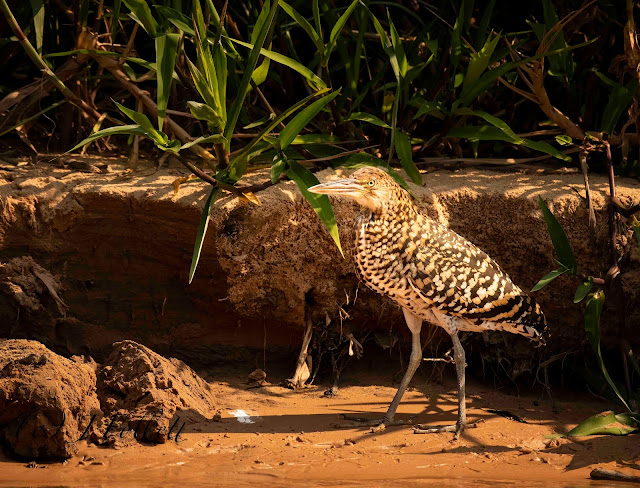Chapter Twenty-six
Bad Day at Black Rock
The cockroach is dead.
At least, I think it is. It no longer has appendages to wave about to indicate otherwise and it looks somewhat shriveled. The ants are still around it and somehow the cockroach is located about a foot from where it was last night. Did the ants carry it?
Lingering in the back of my mind is how the roach fell prey to the ants in the first place. Bug spray? Will the ants die if they consume the roach? Will birds die if they consume the ants? Will rodents and other birds die if they consume the birds? The possible effects are endless.
I try to put all this out of my mind and think about all the adventures we will have on the river today,
As it turned out, maybe the cockroach was foreshadowing the events of today.
***
We’re off like a rocket on the river today and my hat is now firmly tethered to a belt loop on my safari pants.
 |
| I used a very flexible camera strap to tether my Tilly hat to a belt loop only safari pants. |
No one tells us what’s going on. If they had, I might have asked to vary the agenda.
We make our way through the floating water hyacinth to a scrum of boats shoving as far into the vegetation as they can toward shore. Before us is a large tree and everyone is staring at it.
I ask what is happening and I’m told that a male jaguar killed Medrosa’s young male cub, the very one we were photographing a couple days ago. I ask Shelly if she can see it and she says she can see the blood.
The male is lingering in the vicinity and I catch a glimpse of his back in the tall grass.
I sit down. I take no photos and I don’t try to see the blood.
 |
| Medrosa's cub Aimee, killed by a male jaguar. |
Like lions, leopards, bears and other animals, males will kill the young of females. The female will then stop lactating and be receptive to mating with the male.
It’s nature. At its worst, in my opinion.
Suddenly, we leave in a hurry. “Bees!” says Octavio. Fine by me.
We didn't know this until later, but we witnessed history today. It has always been suspected that male jaguars, like other wild cats and bears, will kill the cubs of females, but until today it has never been DOCUMENTED. The film crew is there to record it.
The cub disaster took place in a lagoon and that offers me a chance to photograph some birds.
The morning light was perfect for photography, lending a warmth to colors.
This anhinga is facing away from the sun, it wings spread to allow the sunlight to dry the wings feathers.
Anhingas, along with cormorants, are considered prehistoric birds in that they do not produce oil to spread on their feathers like other water fowl. They are large birds of 35 inches in length with a wingspan of 37.5 inches.
Also called snakebirds, darters, American darters, or turkey birds, anhingas swim almost totally submerged but for their long neck and head, hence the "snakebird" name. Another unusual element of the anhinga is their lack of nostrils. Breathing is done entirely through the epiglottis, a flap in the throat that allows air in and closes to keep water and food out.
 |
| Anhinga drying its wings. |
 |
| Anhinga |
 |
| Anhinga |
 |
| A tiger heron juvenile. |
When it's all grown up, the chick will look like the adult below, which measures about 30 inches in length.
Which brings up an interesting question: how do "they" derive a bird's length. It's done by laying a dead bird on its back and measuring from the tip of its bill to the tip of its tail.
 |
| A female ringed kingfisher. She was perched and sunning herself when we first saw her. Here, as the boat approaches, she begins to prepare to fly away. |
We move out of the lagoon and into another by-way of the river where we find several caimans sunning themselves.
It was not until I was editing and cropping the photo above that I noticed something and zoomed in to see what was.
There is something on the caiman's snout!
And it's a butterfly!








Your words Gullible. .. "A Bad Day at Black Rock. Like lions, leopards, bears and other animals, males will kill the young of females. It’s nature. At its worst, in my opinion". .. We sure agree with you, nature at its worst! It cast "a Pall" (an unpleasant situation or piece of news) over the rest of the Post for us. But what is, IS and you're just writing about what you witnessed. Cap and Patti
ReplyDeleteI have seen a number of sad things in nature, like the killing of Medrosa.'s cub. Somehow, when you've "interacted" with an animal to the extent that spending time with it and photographing it and bringing its image and memory home with you, it affects you more.
DeleteYou nailed it Gullible! We felt betrayed when the male Jaguar killed our very own Aimee .. Medrosa's Cub !! OUR Cub !! Bah Humbug bad male Jaguars in general. Cap and Patti
DeleteNature is beautiful but, unfortunately, it can also be cruel. It is survival of the fittest. Beautiful photos.
ReplyDeleteI spotted the jaguar, but only because you said there was one there. He sure blends in well. Nature can be so wonderful and also so heartbreaking. And now I must investigate the chocolate covered bacon link I see off to the right. I remember hearing about this 'treat' at the Minnesota State Fair years ago. I could bring myself to try it, even though I love chocolate. My taste buds refused to consider it.
ReplyDelete